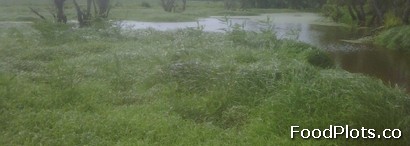Of all the different types of hunting, nothing is more fun that waterfowl hunting, at least in my opinion. Duck hunting in the early morning over a marsh or pass shooting the open prairie while goose hunting is about as good as it gets when the action is hot! One way to ensure that the birds stay in your area is to develop food plots for ducks and geese on your property. Of course, make sure you become very familiar with the U.S. migratory bird hunting laws, and contact your local game warden to clarify if you have any questions regarding developing and hunting a food plot for waterfowl.
Ducks love millet. Browntop and white proso millet are highly sought after by several duck species, so if you have this in your food plot you will have birds on top of you. Browntop millet has a maturation date of only 60 days, and white proso millet of 70 days, meaning these species will grow quick for both you and the ducks in the fall. An important consideration with food plot seeds for waterfowl is how quick the seed deteriorates under water. You want the seeds to be edible while they remain under water throughout the season for hungry, migrating birds.

Browntop and proso millet have a deterioration rate of about 25 percent after 90 days of inundation, making this mixture a great food plot mix for ducks. Plant along lakes, beaver ponds and marsh areas inhabited by ducks or used by ducks during their migratory season. Millet food plots are best when sited in areas that are prone to seasonal flooding or that can be flooded manually when plants have matured. For this wildlife-attracting seed mix, seed 15 pounds of browntop millet and 15 pounds of white proso millet per acre during the early fall, hope for cold weather and load up on steel shot.
Another great choice for food plots for ducks is Japanese millet. This millet can be flooded shallowly, but not over-topped by water, soon after emergence and establishment. Shallow flooding supports wetland habitat into the growing season, but also helps provide weed control. Japanese millet has a maturation date of 90 days after germination a seed deterioration rate of 57 percent after 90 days of inundation. The seeds of Japanese millet are not as hardy as those of browntop or proso milet, but a big positive is that Japanese millet will often re-establish in food plot areas where previously grown, if the plant is allowed to mature and produce seed.
This is good for several reasons. First, Japanese millet can save you money on your food plots on an annual basis. Secondly, naturalized Japanese millet, those plants which occur naturally at least one growing season after planted, can be manipulated legally for duck and waterfowl hunting purposes. Hunters can also manipulate other naturally occurring moist-soil wetland plants. Japanese millet should be seeded to food plots at the rate of 25 pounds per acre.
Chufa is often used in food plots for turkey, but it can also be planted for ducks. Waterfowl love the tubers. so this plant can really pull in the birds. Chufa grows best in well-drained sandy loams, but it can be grown in predominantly clay soils as well, which is a good thing because most guys do not duck hunt over well-drained sandy soils. Chufa does need nutrient-rich soil though, so get a soil test and and increase P and K levels as necessary.
Chufa is a great food plot for ducks and goose hunting when seeded at a rate of 40 pounds per acre, but it does take more work than other food plots. After your chufa has grown to 6 to 12 inches in height, top dress with ammonium nitrate at the rate of about 90 to 180 pounds per acre. Chufa matures approximately 100 days after germination. Chufa plots are excellent for migratory waterfowl, but they can get expensive because the seeds are expensive, it requires a lot of fertilizer and you may have to control competition from weeds.
Other food plots that work well for whitetail deer as well as for geese are winter wheat and/or ryegrass. Farmers know that geese and some duck species relish wheat, and geese will readily consume ryegrass fields or food plots. Wheat should be planted at the rate of about 90 pounds per acre, ryegrass at 25 pounds per acre, and then either left on dry land or flooded after it reaches about 6 inches in height. Shallow-flooded wheat and/or ryegrass produces an excellent food source for geese and wigeon, but snow geese and white-fronted geese (speckled bellies) will also use these food plots in uplands.
High-quality food plot mixes for ducks and geese do not have to be expensive, or fancy for that matter. A great seed mix is just to combine corn and milo (grain sorghum). Ducks and geese love these two seeds, so having them available on your property during the hunting season make perfect sense. A good rule of thumb on this mix is to seed about 7 pounds of seed corn and 5 pounds of milo per acre of food plot. These seeds hold up fairly well for ducks and gees, with about a 50% seed deterioration rate after 90 days.